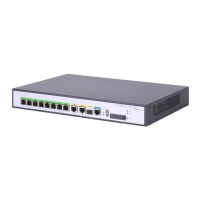432
ASPF commands
In this chapter, "MSR1000" refers to MSR1002-4. "MSR2000" refers to MSR2003, MSR2004-24,
MSR2004-48. "MSR3000" collectively refers to MSR3012, MSR3024, MSR3044, MSR3064.
"MSR4000" collectively refers to MSR4060 and MSR4080.
aspf apply policy
Use aspf apply policy to apply an ASPF policy to an interface.
Use undo aspf apply policy to remove an ASPF policy application from an interface.
Syntax
aspf apply policy aspf-policy-number { inbound | outbound }
undo aspf apply policy aspf-policy-number { inbound | outbound }
Default
No ASPF policy exists on an interface.
Views
Interface view
Predefined user roles
network-admin
Parameters
aspf-policy-number: Specifies an ASPF policy number in the range of 1 to 256.
inbound: Applies the ASPF policy to incoming packets.
outbound: Applies the ASPF policy to outgoing packets.
Usage guidelines
To inspect the traffic through an interface, you must apply a configured ASPF policy to that interface.
Make sure a connection initiation packet and the response packet pass through the same interface,
because an ASPF stores and maintains the application layer protocol status based on interfaces.
You can apply an ASPF policy to both the inbound and outbound directions of an interface.
Examples
# Apply ASPF policy 1 to the outbound direction of GigabitEthernet 2/1/1.
<Sysname> system-view
[Sysname] interface gigabitethernet 2/1/1
[Sysname-GigabitEthernet2/1/1] aspf apply policy 1 outbound
Related commands
• aspf policy
• display aspf policy all
• display aspf policy interface

